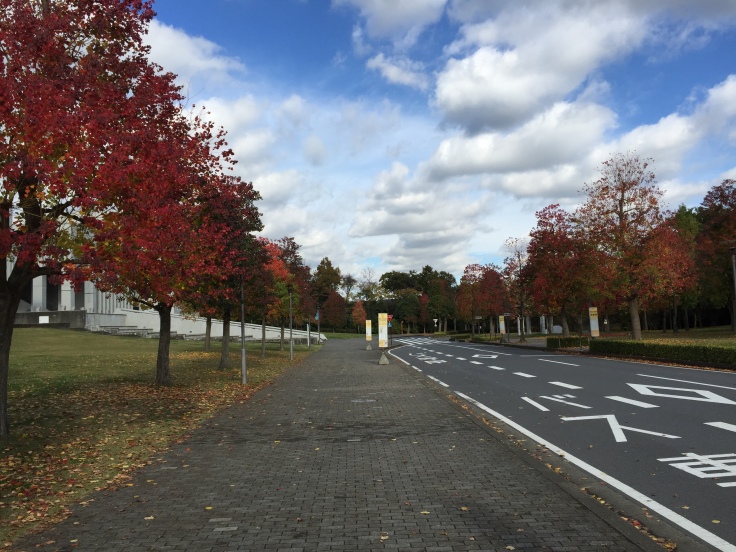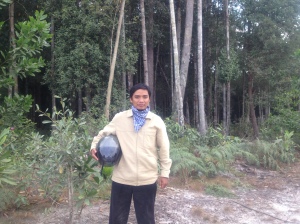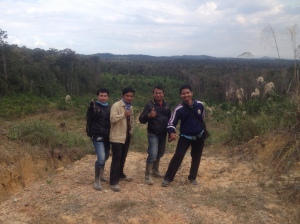Badminton is part of my life. As general secretary of Indonesia Badminton Association in Sambas Regency, I do regular practice with my friends. This hobby has no reason to be stopped in my study period in Japan. During my first year as Doctoral Student at Keio University, I joined Keio Badminton Open 2015 which is held by undergraduate student across
Photo-photo ini saya ambil pada tanggal 17 Desember 2015 tepat tengah hari. Lokasi terletak dikawasan Guest House Keio, Shonan Fujisawa Campus. Tempat yang jarang sekali saya lewati. Bahkan setahu saya sangat jarang orang yang sengaja lewat disitu karena letaknya yang memang agak terpencil. Pada hari itu entah kenapa saya terniat untuk menuju ke Zeta Building melalui kawasan ini.
 Autumn in SFC is always wonderful. Color of leaves turns red and yellow. Blue sky and clean environment are prettily mixed with buildings. It is often that some people enjoying the scenery are also adding the beauty.
Autumn in SFC is always wonderful. Color of leaves turns red and yellow. Blue sky and clean environment are prettily mixed with buildings. It is often that some people enjoying the scenery are also adding the beauty.
This beautiful scenery can be maintained because all people has a good awareness on preserving their environment. Developing beautiful landscapes can be worthily ‘ibadah for moslems. As Allah SWT loves beauty.
Prophet Muhammad (PBUH) said: “Allah is beautiful and He loves beauty.” (Sahīh Muslim: 911)
We can also be reminded by the beautiful threes around us about our creator. Allah SWT said in al Quran:
Is it you who produced its tree, or are We the producer? ( al Quran; 56:72)
Prophet Muhammad (PBUH) said: “The example of a believer is that of a fresh tender plant; from whatever direction the wind comes, it bends it, but when the wind quietens down, the plant becomes straight again” (Bukhari)
This picture was taken 13 February 2014 during on my way home from a tour of duty to Sajingan Besar. The forest depicted on this picture is a community’s protected forest. One among very few forest can be preserved in the area which have been experiencing massive exploitation, particularly by large scale palm oil plantations. On the other hand, the needs for land utilization by local communities are also growing leads to high acceleration of deforestation of origin rain forest in the norther part of West Kalimantan Province.
be preserved in the area which have been experiencing massive exploitation, particularly by large scale palm oil plantations. On the other hand, the needs for land utilization by local communities are also growing leads to high acceleration of deforestation of origin rain forest in the norther part of West Kalimantan Province.
All around Sambas Regency area, there have been massive land use change. Tall rise trees which one land marked villages have been rarely seen. Morris trees for example, once known as useless trees with big and tall-rised grow, hardly be found in peat-land areas of the regency. The trees have been replaced by Palm Oil trees.

My second part of living in Japan is more challenging than before. Housing is first of challenges that I have to struggle for. Due to various administrative clearances, I had to stay at my best friend house for almost two weeks. It was a long stay at a Japanese family. I feel so sorry for disturbing their daily life during that period.
Seeking a good house for longer stay in Japan required many determinations. Several variables need to be taken into account. Safety and accessibility to Campus and my daughter’s potential Elementary School are among those to mention. Anyway, from this experience I learned a lot about how landscapes change over time in specific area. How people distribute on space.
In Islamic teaching there are a lot of literatures can be used to explain this phenomenon.
Prophet Muhammad (PBUH) said “There are three things that are essential for happiness: a righteous wife, a spacious home, and a sound means of transportation” (Musnad, 1:168)
The word of ‘house’ or something refers to it were mentioned 28 times in the Holy Qur’an (The Quranic Arabic Corpus). Amongst them is below verse:
And [mention] when We made the House a place of return for the people and [a place of] security. And take, [O believers], from the standing place of Abraham a place of prayer. And We charged Abraham and Ishmael, [saying], “Purify My House for those who perform Tawaf and those who are staying [there] for worship and those who bow and prostrate [in prayer].” (Al-Quran; 2:125)
on the other verse, Allah said:
“My Lord, forgive me and my parents and whoever enters my house a believer and the believing men and believing women. And do not increase the wrongdoers except in destruction” (Al-Quran;71:28)
-
Reciprocal relationship between human and the environment has always been attracting me. More interesting is scrutinizing the history of humankind and the history of geography. Historical geography is new for me but less than a chapter reading to make me tempted to know more about it. This book of J.B. Mitchel is a good start to learn more about this useful major. Despite of its old publishing, this book has basic concepts relevant to even most update development of the knowledge. For instance, even though Geographical Information System was not yet well established during this book was being written, what now known as Historical Geographical Information System is, as long as my understanding, conceptually developed based on this book frameworks.
-
I summarized the book to highlight its most important points for starter.
J.B. Mitchell (1954) Historical Geography. English Universities Press Limited. London.
What is Historical Geography
Historical geographer is a geographer first, last and all the time, and therefore his first task is to teach himself geography (p.2)
The two essential questions that the geographer must ask are “where?” in order to find out how this are arranged in his place, and then “why there?” in order to appreciate the arrangement that he has found. (p5)
What is Historical Geography
A geographical fact is any fact that can be mapped on the earth’s surface, any phenomenon that has an address.(p7)
The most fundamental facts, or rather groups of facts, are those relating to world position, climate, land and water forms, soils, plants, animals, men and the economic, political and social activities of men in organized communities. (p8)
What is Historical Geography
Many books with the title Historical Geography would be better entitled Geographical History for they are concerned essentially not with the place but with the civilization. (p11)
Historical Geography is, simply stated, a geographical study of any period in the past for which a more or less ordered and dated sequence is established in human affairs.
What is Historical Geography
The historical geographer is thus concerned mainly with the social, economic and political geography of an area at some past time. (p14)
The great themes of historical geographer concern then the long-lasting, stable elements of the geographical scene: the distribution of peoples, the patterns of settlement, the soil and vegetation zones that develop as fields and pastures replace forest, marsh and moor-the study of these lead back in most areas to much earlier ages than the present.(pp14-15)
THE DATA OF THE HISTORICAL GEOGRAPHER
The HG desires the facts about his place in the past to fulfill three conditions: he wants them to be strictly localized, to have a fixed position in space; he wants them to be well, that is evenly, distributed over the area; he wants them to be representative of their kind since he seeks examples of the rule rather tan the exception within the area. (p18)
All kinds of indirect evidence, a bit here and a bit there, must be pieced together to five clues. (p19)
THE DATA OF THE HISTORICAL GEOGRAPHER
The most important sources of material for historical geographical study are:
Archeological finds i.e. the material remain of earlier societies ranging from skeletons and small ornaments, tools and weapons, to houses, forts, castles, temples and churches, including buildings more usually thought of as names;
Statistical and quasi-statistical material, perhaps unreliable and certainly incomplete in earlier periods, becoming almost overwhelming in abundance in the nineteenth century;
Acts of parliament and the reports of parliamentary commissions;
Contemporary histories and geographies of topographies as they were more often called;
Contemporary journals and travel books;
Contemporary road books and maps (p20)
The study of archeological finds and of the architecture of our buildings does much to supplement the written record, especially in the investigation of the geography of early periods. (p20)
Place names carefully used provide much valuable evidence. (p22)
The great bulk of the data used by the historical geographer is found in the written records of the past. (p25)
Road books, maps and atlases of contemporary date are of course another source of first importance to the historical geographer (p32)
The data culled from whatever source must be handled geographically: it must be studied inn a way that will bring out the facts of distribution and of space relationship. (p38)
THE GEOGRAPHY OF SETTLEMENT: THE PEOPLING OF THE LAND
Since lands without peoples are lands without history, it would seem clear that the period of the first settlement of the lands is the earliest period in which the historical geographer will be interested. (p41)
Any geographical study of any place at any time may thus well begin with a study of the peoples of the land. (p43)
It is desired to find out who the peoples are who contribute to the population, where they come from, when they came and in what numbers they settled. (p46)
Peoples may be identified by their skeletons, by their culture in the archeological sense, i.e. by the general character of their material possessions, and by their language. (p47)
The reader is advised to consider the people of his own area: to look at them, to observe the shape of their heads, the build of their bodies, the colour of their hair and eyes, to ponder their habits; to listen to their tongues and to say their names.(p47)
THE SETTLEMENT OF THE LAND
The pattern of settlement, the distribution of villages and towns, their size and number and building materials, does much to give geographical character to an area. (p82)
THE SETTLEMENT: THE TOWNS
To study the geography of a town effectively it must be examined in relation to the conditions of the period of its origin and growth; the study is essentially one in historical geography.(p125)
Every reader will gain much by examining for successive periods the plan of a town he knows well in relation to its situation, its site and its place in the political, economic and social life of the area.(p129)
The consideration of sound foundations and good water supplies which affect the choice of village sites apply with even greater force to towns.(p132)
If dry and level ground for building was limited in many towns and cities, then as population grew houses became more and more crowded on the restricted area and water supplies became not only short but contaminated.(p133)
THE CHANGING GEOGRAPHY OF THE CONTRYSIDE
The distribution of the different uses of land had a well-marked regional pattern, reflecting in general and in detail primarily variations in relief, climate and soil, and in the density of population.(p173)
If the clearance of woodland wrought the most widespread transformation in the landscape, the draining of bog and fen brought about locally the most dramatic changes. (p186)
The place names containing elements associated with fen and blog help in the study of marshland in the same way as those cotnaining words for trees or clearings help in studying the woodlands. (p188)
THE CHANGING GEOGRAPHY OF INDUSTRY
The location of industry depends very largely upon the abundance of the raw materials found of produced within or easily imported to, the area; the physical condition required by the techniques of the time; the amount and skill of local labour; and the position of the markets. (p222)
THE CHANGING GEOGRAPHY OF COMMUNICATIONS AND TRANSPORT
Paths and roads, navigable rivers and canals, and railways are in themselves conspicuous geographical features; but their greatest importance lies not in this but in the function they perform.
The pattern of settlement, of agriculture and industry, is closely related to the pattern of communications, natural and man made.
THE PLACE OF HISTORICAL GEOGRAPHY IN THE GEOGRAPHICAL SINTHESIS
Every geographer, whatever the stage of his study, must at one and the same time be conscious of the immensity of the whole, yet must consider it part by part if he is to examine his material in sufficient detail to understand the complexities involved and see exactly how the parts from smallest to largest interact and interlock.(p325)
The grouping of living things, plants, animals and men within the area, the characteristic feature of the group and of its distribution, depends in most cases upon a long association between society and place.
Present physical geography reflects not only the effects of the work of present inhabitants and of present societies, but the effects of the work of past inhabitants and of past societies.
The more he knows of the geographical patterns of the past and the way in which they have changed the better he is able to appreciate the intricate and complexly inter-related consequences that any alteration in even one element of his environment may bring about.
THE END















Recent Comments